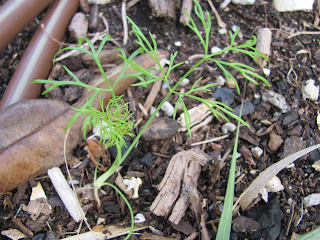These are a couple of our worm bins that we use to dispose of our compostable household waste. This is mostly fruit and vegetable scraps, tissues, other paper plus some weeds and lots of dry stuff from the bannah grass we have growing to protect us from the south west wind and afternoon sun.
We prefer this style of worm farming as they can escape the heat or cold if they need to, which they're unable to do in the high rise type set-ups. We're lucky to have somewhere to do this.
The first one is a stack of tyres, piled so they don't have gaps for rodents to enter. It is next to a dwarf almond, which should benefit from it's wormy friends.
The bannah grass and Acacia leaves make great compost (but we just killed the Acacia, oh well).
This Dalek looking Gedye bin was found somewhere with no lid. This lid is from a Webber cooker, which there are often many of at verge side collections.. It works well as a worm cover as the moisture falls back in. The worms get up around the edge of the bin and lurk about.
Pulling apart the bin is a bit of a progression in that it takes a few goes to get there. If you don't mind cockroaches you can maybe go quicker.
The top layers tend to harbour cockroaches. I let them escape and leave the lid off so that the worms can retreat into the dark. That's when I take a few bucketfuls of the worm goodies and spread them around or put them somewhere out of the sun and rain. Once you expose worms, leave it again for a few hours/days. Then you can collect some more. It gives a few things a chance to move out before you take their home away.
As I rolled the tyres around big clods of worm poo was falling out.. fertilising on the go!! The tyres are going to be moved to a new spot in our front garden to help the hedge grow faster.
This one has lots of roots in it. I'm guessing asparagus, but not sure yet. Have to keep digging.
This is the lower part of the worm bin, it is drier and a bit more aged. Even if the nutrients are gone, this adds humus and structure to the soil when it is added. As you can also see, we eat a bit of chicken. One weird phenomena with these loooong time composts is that as you get closer to the bottom, more and more concentrated layers appear.. eggshells, bits of plastic, some still totally readable and brightly coloured. And allllll the bones.. I did put a dead raven in here at one point.. didn't manage to come across it's skull though in my unruly vermicompost digging.
Now This is the point of my post. All the bits of plastic. Some of these things are obviously plastic but some of the labels are a bit of a surprise. Still shiny and readable.
Good to see no teabags or the crinkly plastic bags that we were buying salad leaves in for a while.
It adds a fair bit of time to having to sort it out though and these little bits of plastic and bones are fiddly to have to pick out. We have a sieve (plastic plant tray with big holes) to help get some of the bones out.
This is not a worm egg. It's a worm poo egg. This shows why it is good to crush eggshells before putting them in. If you rinse the shells when you use them they crush easier when dry and can be pulverised in a blender.















































